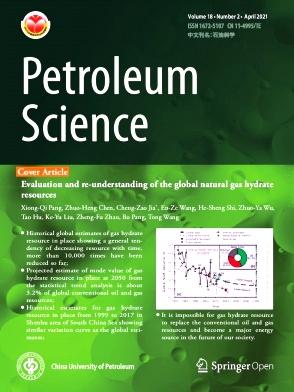中国西部四川盆地中部中二叠统栖霞地层面控白云岩的起源及其勘探意义
IF 6
1区 工程技术
Q2 ENERGY & FUELS
引用次数: 0
摘要
中二叠统栖霞地层台内浅滩白云岩是目前四川盆地中部油气勘探的重点目标。为系统研究栖霞地层层控多孔白云岩的成因,本研究开展了岩石学、测井和地震综合分析。研究结果如下(1)白云岩储层在四川盆地中部具有普遍性,其分布受台地内滩涂控制,垂直方向多层叠加。厚块状白云岩也可随断层发育。(2) 发现三种置换白云岩和一种白云岩胶结物:极细至细晶、正方体至次正方体白云岩(Rd1);细至中晶、正方体至次正方体白云岩(Rd2);粗晶、次正方体至优长方白云岩(Rd3)和粗晶鞍状白云岩胶结物(Sd)。Rd2 和 Rd3 有部分结构保留,并保留了原始的生物碎屑。Sd 呈波浪状消光,填充在角砾岩脉中。(3) U-Pb 测年和均质温度结果表明,白云岩和 Sd 胶结物与峨眉山大型火成岩期的热液事件有关。δ13C、87Sr/86Sr和海水样REEY模式表明,白云岩和Sd沉淀流体来源于被高热流加热的海相海水。(4) 在东武运动时期,ELIP引发了盆地大规模的热异常。温度和压力的升高推动了平台内浅滩面的地层水,并克服了 Mg2+ 水合物的结合效应。此外,深部热液沿着断层和裂缝优先渗透到浅滩面的多孔地层中,在一定程度上与地层水混合,发生了广泛的白云石化。面控白云岩储层与下伏寒武系源岩形成了良好的源-储层组合,可作为一种重要的替代选择。本文章由计算机程序翻译,如有差异,请以英文原文为准。
Origin of facies-controlled dolomite and exploration significance of the Middle Permian Qixia Formation in central Sichuan Basin, Western China
The intraplatform shoal dolomite of the Middle Permian Qixia Formation is currently considered the key target of hydrocarbon exploration in the central Sichuan Basin. To systematically investigate the origin of the stratabound facies-controlled porous dolomites of the Qixia Formation, integrated petrography, logging and seismic analysis were carried out in this work. The results are as following: (1) the dolomite reservoir is universal in the central Sichuan Basin, and its distribution is controlled by intraplatform shoals, with multilayer superposition vertically. Thick massive dolostone may also develop along with the fault. (2) Three replaced dolomites and one dolomite cement were identified: very finely to finely crystalline, anhedral to subhedral dolomite (Rd1); finely to medium crystalline, anhedral to subhedral dolomite (Rd2); coarsely crystalline, subhedral to euhedral dolomite (Rd3) and coarsely crystalline saddle dolomite cement (Sd). Rd2 and Rd3 are partly fabric-retentive, and preserve the original bioclastic ghosts. Sd shows wavy extinction, filled in the breccia veins. (3) The U-Pb dating and homogenization temperatures results indicate that the dolomite and Sd cement are associated with hydrothermal event during the Emeishan large igneous province. The δ13C, 87Sr/86Sr, and seawater-like REEY patterns suggest that the dolomitization and Sd precipitation fluids originate from connate seawater heated by elevated heat-flow. (4) The ELIP triggered large scale thermal anomalies in the basin during the Dongwu movement period. The increased temperature and pressure drove the formation water in the intra-platform shoal facies and overcame the binding effect of Mg2+ hydrate. Moreover, the deep hydrothermal fluid preferentially penetrated into the porous strata of shoal facies along the faults and fractures, mixed with formation water to some extent, and extensive dolomitization occurred. The facies-controlled dolomite reservoir and the underlying Cambrian source rock form a good source-reservoir assemblage, which can be a key replacement option.
求助全文
通过发布文献求助,成功后即可免费获取论文全文。
去求助
来源期刊

Petroleum Science
地学-地球化学与地球物理
CiteScore
7.70
自引率
16.10%
发文量
311
审稿时长
63 days
期刊介绍:
Petroleum Science is the only English journal in China on petroleum science and technology that is intended for professionals engaged in petroleum science research and technical applications all over the world, as well as the managerial personnel of oil companies. It covers petroleum geology, petroleum geophysics, petroleum engineering, petrochemistry & chemical engineering, petroleum mechanics, and economic management. It aims to introduce the latest results in oil industry research in China, promote cooperation in petroleum science research between China and the rest of the world, and build a bridge for scientific communication between China and the world.
 求助内容:
求助内容: 应助结果提醒方式:
应助结果提醒方式:


